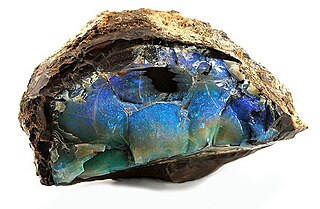
Opal is a hydrated amorphous form of silica (SiO2·nH2O); its water content may range from 3% to 21% by weight, but is usually between 6% and 10%. Due to its amorphous property, it is classified as a mineraloid, unlike crystalline forms of silica, which are considered minerals. It is deposited at a relatively low temperature and may occur in the fissures of almost any kind of rock, being most commonly found with limonite, sandstone, rhyolite, marl, and basalt.

Petrified wood, also known as petrified tree, is the name given to a special type of fossilized wood, the fossilized remains of terrestrial vegetation. Petrifaction is the result of a tree or tree-like plants having been replaced by stone via a mineralization process that often includes permineralization and replacement. The organic materials making up cell walls have been replicated with minerals. In some instances, the original structure of the stem tissue may be partially retained. Unlike other plant fossils, which are typically impressions or compressions, petrified wood is a three-dimensional representation of the original organic material.

Aegypiinae is one of two subfamilies of Accipitridae that are referred to as Old World vultures, the other being the Gypaetinae. They are not closely related to the Gypaetinae, and are instead a sister group to the serpent-eagles (Circaetinae).

Amateur geology or rock collecting is the non-professional study and hobby of collecting rocks and minerals or fossil specimens from the natural environment. In Australia, New Zealand and Cornwall, the activities of amateur geologists are called fossicking. The first amateur geologists were prospectors looking for valuable minerals and gemstones for commercial purposes. Eventually, however, more people have been drawn to amateur geology for recreational purposes, mainly for the beauty that rocks and minerals provide.

Vivianite (Fe2+
3(PO
4)
2·8H
2O) is a hydrated iron phosphate mineral found in a number of geological environments. Small amounts of manganese Mn2+, magnesium Mg2+, and calcium Ca2+ may substitute for iron Fe2+ in the structure. Pure vivianite is colorless, but the mineral oxidizes very easily, changing the color, and it is usually found as deep blue to deep bluish green prismatic to flattened crystals. Vivianite crystals are often found inside fossil shells, such as those of bivalves and gastropods, or attached to fossil bone. Vivianite can also appear on the iron coffins or on the corpses of humans as a result of a chemical reaction of the decomposing body with the iron enclosure.
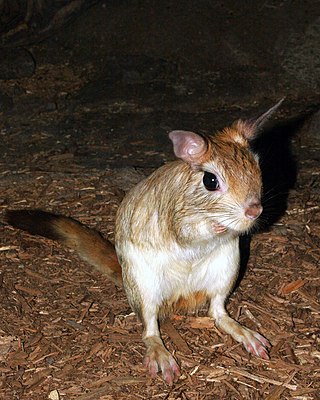
The Pedetidae are a family of mammals from the rodent order. The two living species, the springhares, are distributed throughout much of southern Africa and also around Kenya, Tanzania, and Uganda. Fossils have been found as far north as Turkey. Together with the anomalures and zenkerella, Pedetidae forms the suborder Anomaluromorpha. The fossil genus Parapedetes is also related.
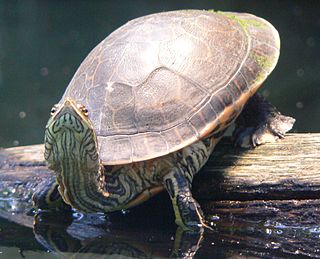
Deirochelys is a genus of freshwater turtle in the family Emydidae, the pond and marsh turtles. It contains one extant species, the chicken turtle, which is native to the southeastern United States. A second extinct member, Deirochelys carri, is known from a fossil found in Alachua County, Florida. The genus was first described by Louis Agassiz in 1857, and its name is derived from the Ancient Greek words for "neck" (deirḗ) and "tortoise" (khélūs), referring to the particularly long necks of these turtles.

Anomaluromorpha is a clade that unites the anomalures, springhares, and zenkerella. It has alternately been designated as either a suborder or infraorder. Most recently, Carleton & Musser 2005 recognized it as one of five suborders of rodents.

Latimeriidae is the only extant family of coelacanths, an ancient lineage of lobe-finned fish. It contains two extant species in the genus Latimeria, found in deep waters off the coasts of southern Africa and east-central Indonesia. In addition, several fossil genera are known from the Mesozoic of Europe, the Middle East, and the southeastern United States, dating back to the Triassic.

Zenkerella is a genus of rodent, the only member of the family Zenkerellidae. It was formerly classified in Anomaluridae until phylogenetic studies made its distinctiveness clear. While the Anomalurus of the family Anomaluridae has gliding membranes between its forelimb and hindlimb, the Zenkerella has no such adaptation. It is estimated from fossil records that this divergence might have occurred in the middle of the Eocene.

Eomys is an extinct genus of eomyid rodent from the late Oligocene of France, Germany, Spain, and possibly Turkey. The species Eomys quercyi is the earliest known gliding rodent.
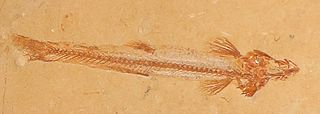
Charitopsis is an extinct genus of prehistoric marine ray-finned fish that lived during the lower Cenomanian. It was a relative of modern beaked salmons. It contains a single species, C. spinosus from the Sannine Formation of Lebanon. It is possibly related to the sympatric gonorynchid Charitosomus, although some anatomical traits are more similar to the Cenozoic gonorynchids.
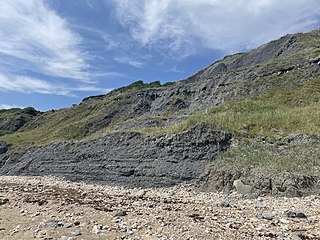
Black Ven is a cliff in Dorset, England between the towns of Charmouth and Lyme Regis. The cliffs reach a height of 130 metres (430 ft). It is part of the Jurassic Coast World Heritage Site. Nearby is an undercliff with an ammonite pavement. The area is popular with tourists due to a number of fossils being found in the area.
Soleniscidae is an extinct family of fossil sea snails, marine gastropod mollusks in the clade Caenogastropoda. It first was seen on the 431 – 427 Ma (Silurian) and its last recorded appearance was in Late Triassic. It is found in the Americas, South Asia and Asian islands, Europe, Northern edge of Africa.

The Kupferschiefer or Kupfermergel, is an extensive and remarkable sedimentary unit in Central Europe. The relatively monotonous succession is typically 30 to 60 centimetres and maximum 2 metres (6.6 ft) thick, but extends over an area of 600,000 square kilometres (230,000 sq mi) across the Southern Permian Basin. The Kupferschiefer can be found in outcrop or in the subsurface straddling six countries, including parts of the southern North Sea. The lateral equivalent outcropping in England is called Marl Slate.
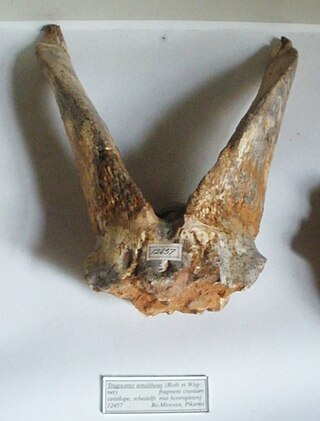
Tragoportax is an extinct genus of bovid ungulate. It lived during the upper Miocene, and its fossils have been found in Europe, Asia and Africa. Tragoportax is sometimes considered to have been a close relative of the extant nilgai, though it may have formed its own subfamily, along with Miotragocerus.
Conomedusites was a creature from the Ediacaran biota. The Ediacaran period ranged from 635 to 539 million years ago. Its fossil was first discovered in 1966 by Martin F. Glaessner and Mary Wade in South Australia. Conomedusites is believed to have been part of the phylum Cnidaria due to its similar structure to jellyfish and other cnidarians, but this is not known for certain. Conomedusites is thought to have been a stationary osmotroph.
Phestia is an extinct genus of clam belonging to order Nuculanida and family Nuculanidae.
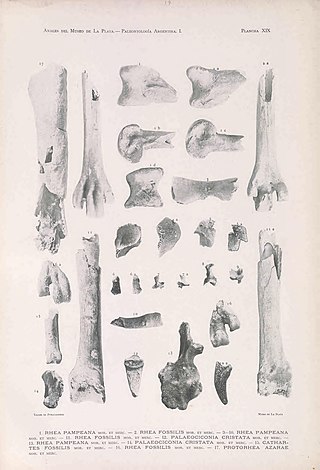
Rhea fossilis is an extinct species of bird in the genus Rhea that inhabited the Southern Cone of South America during the Neogene period. Its closest living relatives are the greater rhea and the lesser rhea.
Ectypodus is an extinct genus of mammals, containing the species E. aphronorus, E. childei, E. musculus, E. lovei, E. powelli, E. szalayi, and E. tardus.














